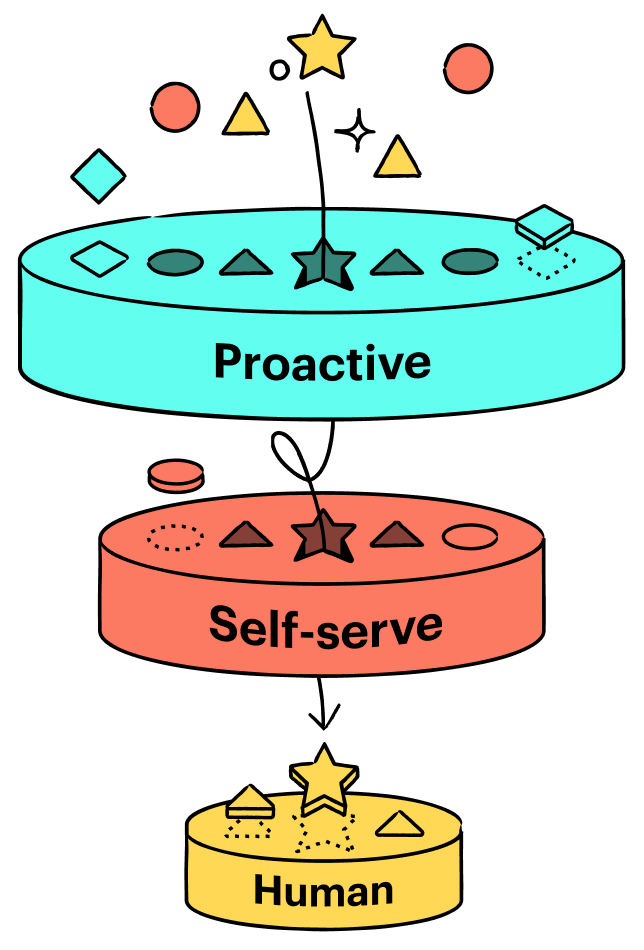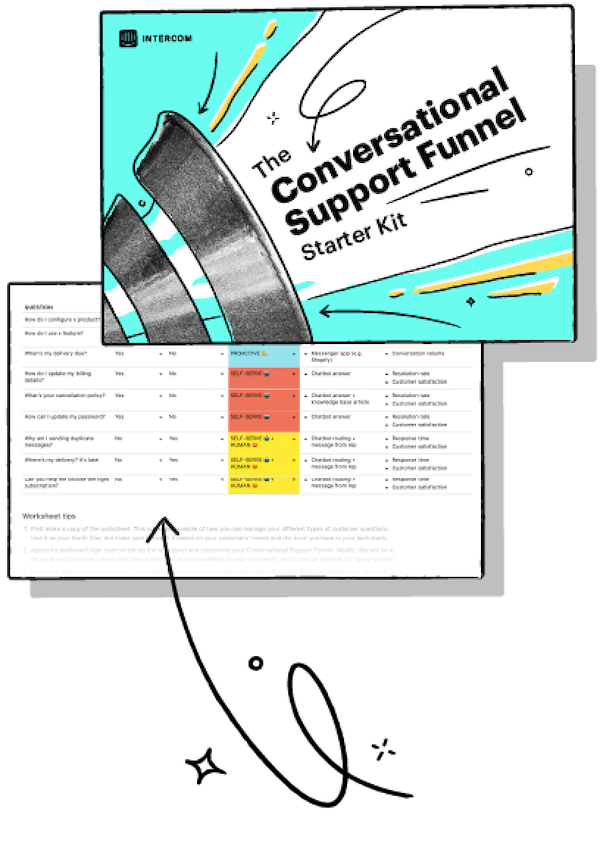If you had any lingering doubts, it’s now official. Providing great customer support is no longer optional — it’s essential to business survival.
More than ever before, poor quality support can make or break a business. But our teams are drowning in increased volumes of queries from customers who expect rapid and personal resolutions. Is it any wonder your team seems constantly on the edge of burnout?
Luckily, there is a way to square the circle. It’s called the Conversational Support Funnel.
What is the Conversational Support Funnel?
The Conversational Support Funnel offers a way off the treadmill support teams have found themselves trapped on. Using a messenger-first model, it combines proactive, self-serve, and human support capabilities so you can get ahead of known problems before they arise, automatically answer repetitive questions with bots, and quickly resolve complex issues by getting them to the right team member.
It’s the most effective, efficient way to provide personal support, at the scale your business needs as it grows.
When you are delivering customer support through a messenger-first experience, there are three distinct modes of support you can offer:
- Proactive support
Get ahead of known problems before customers reach out.
- Self-serve support
Answer repetitive questions automatically.
- Human support
Quickly resolve complex issues one-on-one.

The proportion of your caseload that is resolved at each layer will depend on the unique characteristics of your business. You may already be providing messenger-first support, but not yet be offering all three types of support to your customer. The Conversational Support Funnel is designed to flex and adapt to the needs of different types of businesses.
Let’s jump in and see how each element of the Conversational Support Funnel has a role to play in liberating your support team.
Stay up to date on the Conversational Support Funnel
It’s time for Conversational Support
Study after study, not to mention the bitter experience of businesses who learned the hard way, has shown that customers who don’t get great support will look for it elsewhere. Poor support is now one of the leading causes of people switching brands.
Now that we’re all operating at internet scale, we can serve even more customers around the globe. But that also means we’ve got even more people with higher expectations of great support. And COVID-19 has just increased the pressure.
Businesses of all types are coping with spikes in support volume, have even fewer resources to handle them, and have had to handle a shift to working remotely for an indefinite period.
Intercom’s own research backs this up. The vast majority (74%) of customer support leaders have seen a decline in team morale since the outbreak of COVID-19, and almost half (49%) reported that this drop in morale has negatively impacted team performance.
Low morale and high turnover among teammates, increasing customer expectations, and unprecedented volumes of support queries might sound like a combination of challenges that can’t be solved, right? But we believe that a messenger-first support experience is the key to regaining control.
We call it Conversational Support. It’s a messenger-first experience, but one that’s way more powerful than simply contacting a call center through a live chat bubble. A true messenger-first experience is targeted and personal, while combining chatbots, apps, and self-serve options so visitors can move quickly to a resolution. The Conversational Support Funnel is simply the framework which ensures every query is answered in the most appropriate way — for your business and your customers.
The Proactive Support layer
Proactive support is at the top of the Conversational Support Funnel for a reason — it’s your first line of defense.
An effective strategy for providing proactive support will help drastically reduce the number of conversations that reach your support team, while also increasing customer satisfaction and retention. So not only do you take pressure off your team, but you can also demonstrate how support is impacting the bottom line with those positive customer satisfaction and retention numbers.
In many ways, proactive support — letting customers know about problems before they even realize they have them — is the Holy Grail of customer support. So why do many of us simply accept this kind of customer interaction should be the sole domain of marketing or product teams?
Our conversations with support leaders show there’s a real appetite for that to change. In a recent survey, we found 78% of support leaders want to move from a reactive to a proactive approach with their support, but only 26% are sure they have the knowledge and tools to do so.
One of the foundational steps in proactive support is onboarding and educating new customers so they are set up for success from day one. This may not have always been seen as the responsibility of the support team at your company. But you’re the people who know what’s confusing new customers, so you're the ones who know how to get in front of those repetitive questions.
Even when customers become regular users of your product or return to make multiple purchases, day-to-day operational issues can still occur, which will cause them to reach out for support. We’re talking about product outages, website downtime, bugs, delays with delivery — all of which can frustrate your customers and wipe out your team’s entire day. Which is why you should consider proactively sending an outbound message to flag the issue with customers and provide support up front. And because Conversational Support is messenger-first, you can always use the Messenger to dynamically surface the most important information for customers and visitors alike.
The Self-serve Support layer
A great support experience doesn’t always involve an interaction with another human.
Today’s customers judge “great” by the effort and speed associated with getting a resolution to their problem. Just as your customers don’t always want to wait in line to talk to a human answering repetitive questions like “How do I update my password?” and “What’s your cancellation policy?”; it can feel like Groundhog Day for teammates too.
No one wins when your team is stuck answering simple, repetitive questions — especially not your customers. The more conversations that pile up in your support queue, the longer all your customers have to wait for a response — including those with complex issues that genuinely need human input to resolve.
This one-size-fits-all approach quickly nets out at a “good enough” customer experience. But in today’s world, “good enough” is no longer good enough. Customers have become accustomed to an on-demand world where their every need can be met almost instantly, 24/7 — whether that’s fast food, the latest news, or same-day delivery from their favorite merchants. When a customer has a simple query, they’ll settle for nothing short of a fast, accurate, personal response. Whether that comes from a human, a chatbot, or an easy-to-find help center article, they really don’t care.
With self-serve support, you can empower customers to help themselves by providing answers to repetitive questions with automated bots and a contextual knowledge base. Delivered through a messenger, chatbots and help center articles are a powerful way to encourage customers to self-serve, right at the moment they need help. While a help center is the traditional way to help customers help themselves, we believe chatbots are now ready for prime time, too, and can be a core part of your self-serve strategy. Improvements in technology mean chatbots have gone from potential irritants to tools for resolving queries in just a few short years. Not surprisingly, our research shows that 50% of support leaders plan to invest more in automation, including chatbots, in the coming year to increase the efficiency of their support team.
Embracing self-serve as a core component of your Conversational Support Funnel allows you to scale your support and provide customers with the fast answers they need, without upping your headcount or over-stretching your team.
The Human Support layer
In case you had any lingering doubts, it’s now official. Providing great customer support is no longer optional — it’s essential to business survival.
Chances are this is where your support team spends the bulk of their time today. They are in the trenches answering as many questions as possible and closing tickets as fast as they can to meet their KPIs. With customer expectations of great service at an all-time high and support volumes increasing as we all adapt to the new normal, it places huge pressure on your teammates.
That’s why the Conversational Support Funnel is all about optimizing where issues are resolved, so that the customers that most need it get to chat with another human. This isn’t just about ticket deflection — it’s about getting the fastest, lowest-effort resolution for every type of customer. With more and more customers falling into the digital native and mobile-first categories, a well-managed funnel will also ensure that you’re not forcing customers to have conversations with your team when either they don’t want to, or the nature of their issue simply doesn’t warrant giving them the most expensive form of support.
Instead, your team can focus on the conversations that add real value for your customers. After all, we know that even the best chatbot can’t help calm an angry customer, investigate a thorny issue, or build rapport with high-value customers quite like your team can.
The good news is that even with human support, your team doesn’t have to go it alone. With the right tools — like workflow automation, messenger apps, and reporting — you can make your human support more efficient, personal, and even more profitable.
But you’ll never break the cycle of burned-out teammates and customers getting mediocre service if you simply stay focused on making human support more efficient. It’s only by adding self-serve, and ultimately proactive support, to the mix, that businesses sustainably start to see happier teammates and even happier customers.
Build your Conversational Support Funnel with Intercom
We’ve learned a lot about Conversational Support. Since 2011, we’ve helped thousands of our customers help their customers. First through live chat, and subsequently through richer and richer messenger-based experiences. Which is why we believe that the Messenger is the best way to provide support — for both customers and businesses.
At its core, the Conversational Support Funnel is a framework for managing customer support. It ensures that different kinds of issues and queries, from different value customers, get the appropriate response. But it’s not tied to a single product or company. Dozens of companies — Intercom customers and others — are already thinking about the levels of service they offer in this way. But they are not yet thinking about or managing it holistically, and they certainly aren’t calling it the Conversational Support Funnel (yet!).
Flexibility is key when building out your funnel. Intercom currently offers products that can be used at each layer of the funnel. From a powerful shared Inbox to a flexible Business Messenger, we’ve got all the tools you need to provide personalized, human support. You can resolve 33% of repetitive questions instantly with tools like Resolution Bot — or further empower customers to self-serve with contextual articles. And if you want to address known issues proactively, we're here to help with tools like Product Tours, Mobile Carousels, and Outbound Messages. Intercom is committed to further developing these and other products that will lead to efficiency gains for your team and stronger relationships with your customers.
The Conversational Support Funnel is the way that the most customer-focused organizations are efficiently harnessing the power of messenger-first experiences. Why not join them before your competitors do?
Learn how to combine human, self-serve, and proactive support to get ahead of known problems, automatically answer repetitive queries, and quickly resolve complex issues.

Learn how to combine human, self-serve, and proactive support to get ahead of known problems, automatically answer repetitive queries, and quickly resolve complex issues.

A powerful framework to automatically resolve simple issues, freeing you up for complex ones

An interactive worksheet to provide fast, personal support

Proven tips to improve customer relationships and team morale





